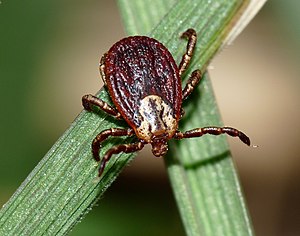Sheep tick
| Sheep tick | ||||||||||||
|---|---|---|---|---|---|---|---|---|---|---|---|---|

Sheep tick ( Dermacentor marginatus ), female |
||||||||||||
| Systematics | ||||||||||||
|
||||||||||||
| Scientific name | ||||||||||||
| Dermacentor marginatus | ||||||||||||
| ( Sulzer , 1776) |
The sheep tick or springtime forest tick ( Dermacentor marginatus ) is a large, strikingly colorful tick from the family of ticks (Ixodidae). It reaches a body length of 3.5 to 5 mm. A fully suckled female can grow up to 15 mm long. The shield, which covers the entire body of the male, is decorated with a silver, dark gray and reddish shimmering enamel color . In females, like other tick species, the shield only covers the front part of the body. The body of the six-legged larva is 0.75 mm long and 0.5 mm wide. The back shield behind the head covers about half of the body. The eight-legged nymphs are 1.6 mm long and 0.9 mm wide. At this stage, the back shield takes up about a third of the top of the body.
Occurrence
Sheep ticks live in warm and dry places such as sunny forest edges and on dry grass. They are particularly common in the Mediterranean area. In Central Europe they live in warm areas such as the Upper Rhine Plain . In the warmer areas of Europe, the sheep tick is the most common type of tick next to the wood tick. The sexually mature sheep ticks are particularly active in early spring and autumn. They are relatively cold tolerant and appear soon after the snow melts. In the summer months, however, mainly larvae and nymphs can be found. The development of the sheep tick takes one to two years.
Way of life
Larvae and nymphs only parasitize on small mammals such as the mole or various rodents . The adult sheep ticks prefer to suckle sheep and brown hares, but also dogs and cats. Humans are also attacked.
Vectors of disease
The sheep tick is one of the carriers of Q fever , a notifiable disease in Germany according to the Infection Protection Act. The pathogens of tularemia ("rabbit plague"), Rocky Mountain spotted fever , Siberian tick bite fever , bovine anaplasmosis and babesiosis in dogs can also be transmitted. Sheep ticks are therefore considered to be important health pests in humans, pets and farm animals.
literature
- Hans-Peter Wirtz: Ticks as a disease carrier: what to do if you get a bite? Biology in our time 31 (4), pp. 229-238 (2001), ISSN 0045-205X
- Heiko Bellmann : Kosmos-Atlas of the arachnids of Europe , Franckh-Kosmos Verlags-GmbH & Co. KG , ISBN 3-440-09071-X
